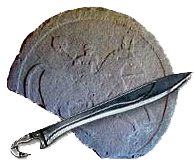Autor:
jueves, 02 de febrero de 2006
Sección: Artículos generales
Información publicada por: Airdargh
Mostrado 22.151 veces.
-
No hay imágenes relacionadas.
Comentarios
 Pulsa este icono si opinas que la información está fuera de lugar, no tiene rigor o es de nulo interés.
Pulsa este icono si opinas que la información está fuera de lugar, no tiene rigor o es de nulo interés.
Tu único clic no la borarrá, pero contribuirá a que la sabiduría del grupo pueda funcionar correctamente.
Si te registras como usuario, podrás añadir comentarios a este artículo.

Aga: El otro artículo de The Independent del día 11. Cuando los vi y recomendé (13/06/2005 0:07:28) eran abiertos; pero casi siempre, menos con El País y algunos otros, se pueden leer luego también en la versión caché de Google; aunque éstos, por su importancia, andan ya circulando en varios websites.
How 7,000-year-old temples reveal the elaborate culture of Europe
The construction of the temples of Nickern, on the site that is now Dresden, puts the first civilisations of Europe at the forefront of early human endeavour to master nature.
Some two millennia before the first stones were laid for the pyramids of Egypt, humanity's preoccupation, from the forests of Germany to the plains of Pakistan, was - both literally and figuratively - to place roots in the soil.
Archaeological evidence suggests that by the fifth millennium BC, tribes in regions such as Baluchistan, on the site known as Mehrgarh, in the north-western corner of the indian sub-continent, and the Samarrans in Mesopotamia were establishing farms and permanent communities.
In Egypt, crops such as flax, cotton and barley were being grown from about 5000BC in villages where herds of sheep and goats were also kept. The discovery of early traces of agriculture in New Guinea from about the same time indicate that across the globe humans were starting to sculpt their landscape.
Dr John Robertson, a Washington University-based anthropologist, said: "There is much of this period that we still don't understand, but humanity was beyond the stage of hunting down prey and smearing itself with the entrails.
"Across the world, man was beginning to see his surroundings as something that could be organised or curtailed - to be farmed. That is a profound change and it did not displace an innate sense of reverence for nature.
"The first civilisations therefore dedicated effort, more often than not huge, into reflecting that in monumental structures."
It is this impetus for a sacred space, such as the early temples dating from this time in Mesopotamia, that appears to be behind the vast structures uncovered in central Europe.
Archaeologists have struggled to pinpoint and outline the development of the first farming communities, because the evidence that they left behind is scanty at best. But the picture that is often drawn of the European context is that an increasingly sophisticated farming culture, with its base in Mesopotamia, roughly the area occupied by present-day Iraq and Syria, was radiating outwards across the Middle East towards the outer reaches of Europe.
On the Orkney islands, complex stone structures such as the Knap of Howar, the earliest standing dwellings to be found in north-west Europe, date from about 3500BC.
Stone, however, is durable and tends to stay in place. By contrast, it has been difficult for archaeologists to establish the degree of sophistication of the civilisation that built the Nickern temples - more than a millennium before the Orkney structures - using timber and earth.
Andrew Sherratt, professor of archaeology at the University of Oxford, said: "The problem has been that all that is often left of these structures are post-holes. It is only when we begin to reconstruct them that we understand the elaborate nature of the culture.
"What appears to have been discovered in Germany is something which might have astonished, for example, Britons, who were only just beginning to farm in this period. But to the Mesopotamians, it would have been the grounds for a rather patronising pat on the back."
While the precise nature of the Nickern round buildings remains a mystery, evidence suggests their owners were sophisticated.
In the early Egyptian village of al-Fayyum, dead domesticated animals were wrapped in linen and buried close to their community. Later evidence from Ancient Egypt offers in insight into the complexity of beliefs that accompanied this practice.
In Nickern, the people who were building their own grand places of worship manufactured ceramic statues of humans and animals - as did the inhabitants of Mehrgarh in Baluchistan - although there is as yet little evidence of the beliefs that drove this practice.
Fuente: http://news.independent.co.uk/europe/story.jsp?story=645972
Hay 1 comentarios.
1